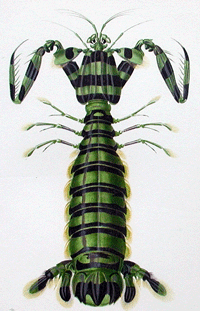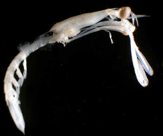To rapidly map biodiversity, stomatopods suggest start with DNA
In “Estimating diversity of Indo-Pacific coral reef stomatopods through DNA barcoding of stomatopod larvae” (FirstCite early online publication in Proceedings Royal Society Biology) Paul Barber and Sarah Boyce, Boston University, look at  a what is thought to be a well-understood group, stomatopods, commonly known as mantis shrimp. Stomatopods are marine crustaceans distinct from true shrimp and are thought to include about 400 species worldwide. Like many marine species, they have a bipartite life cycle where dispersal is achieved through a planktonic larval developmental stage. However, larval stages are notoriously difficult to identify morphologically. Barber and Boyce first established a database of COI DNA barcodes from adult forms of nearly all known species. They then applied DNA barcoding to planktonic larvae collected in light traps at locations in the Pacific Ocean and Red Sea. Comparison of
a what is thought to be a well-understood group, stomatopods, commonly known as mantis shrimp. Stomatopods are marine crustaceans distinct from true shrimp and are thought to include about 400 species worldwide. Like many marine species, they have a bipartite life cycle where dispersal is achieved through a planktonic larval developmental stage. However, larval stages are notoriously difficult to identify morphologically. Barber and Boyce first established a database of COI DNA barcodes from adult forms of nearly all known species. They then applied DNA barcoding to planktonic larvae collected in light traps at locations in the Pacific Ocean and Red Sea. Comparison of  sequences from 189 larval forms revealed 22 distinct larval operational taxonomic units (OTUs), but a minority of these matched known species, suggesting that stomatopod species diversity is underestimated by a minimum of 50% to more than 150%. Their results support general use of DNA barcoding as a rapid, relatively-inexpensive first step in cataloging marine species with planktonic larvae. A similar approach has been applied on land by Smith et al “DNA barcoding for effective biodiversity assessment of a hyperdiverse arthropod group: the ants of Madagascar“.
sequences from 189 larval forms revealed 22 distinct larval operational taxonomic units (OTUs), but a minority of these matched known species, suggesting that stomatopod species diversity is underestimated by a minimum of 50% to more than 150%. Their results support general use of DNA barcoding as a rapid, relatively-inexpensive first step in cataloging marine species with planktonic larvae. A similar approach has been applied on land by Smith et al “DNA barcoding for effective biodiversity assessment of a hyperdiverse arthropod group: the ants of Madagascar“.
DNA barcode OTUs, such as found in these studies, are not equivalent to species descriptions and are not sufficient to establish systematic phylogeny. In my view, these studies indicate that DNA barcodes can be permanent indexers for filing and retrieving biologic information in the encyclopedia of life. Routinely incorporating DNA barcoding into biological surveys will enhance the long-term value of expensive field work.
This entry was posted on Tuesday, May 16th, 2006 at 11:43 pm and is filed under General. You can follow any responses to this entry through the RSS 2.0 feed. Both comments and pings are currently closed.